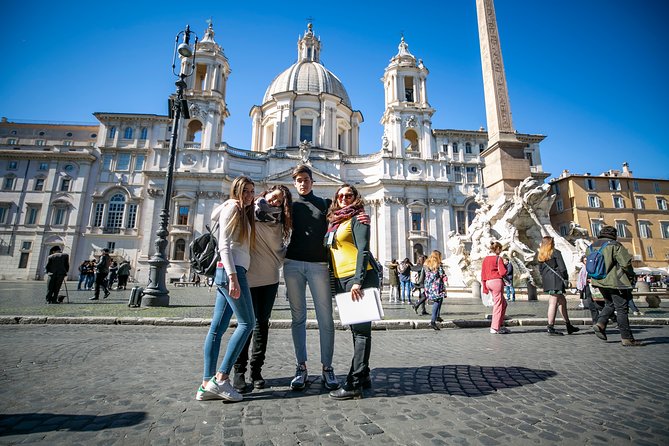
Walking in Rome: Your Guided Tour to the City's Hidden Gems
Explore Rome's enchanting historic center, renowned for its timeless beauty, captivating squares, fountains, and historic landmarks. This comprehensive tour offers the best and most convenient way to witness the must-see sights of the Eternal City. Your journey begins in Piazza Venezia, where you'll enjoy a breathtaking view of the Vittoriano (Altar of Peace). Moving on, visit Largo Argentina, the site of Julius Caesar's assassination, and then proceed to Piazza Navona, adorned with stunning Baroque fountains by Bernini. The tour continues to the Pantheon, a marvel still in use since the 2nd century AD, and concludes at the iconic Trevi Fountain. Finally, immerse yourself in the beauty of Piazza Spagna, located at the base of the famous Spanish Steps, celebrated in film and literature worldwide.
Options
Walking in Rome: Your Guided Tour to the City's Hidden Gems
What's included in Walking in Rome: Your Guided Tour to the City's Hidden Gems
(Subject to Option Inclusions)Itinerary
Colonna Traiana
Located in Trajan's Forum, Rome, the column is approximately 30 meters tall, with an additional eight-meter pedestal. Comprising nineteen marble blocks, it weighs 1,110 tons. Bas-reliefs depict the Dacian wars. Innovative techniques include using a tree to separate scenes. Views from the top offer a panorama. Some interpret it as a tribute to a "genocide" against Dacians, but it primarily celebrates the Roman Army and Trajan, not extermination, as Roman wars aimed at economic and cultural expansion.
Piazza Navona
Piazza Navona is one of Rome's most celebrated squares, located in the Parione district. Its shape resembles that of ancient stadiums in Ancient Rome, following the plan of the Stadium of Domitian, also known among Italians as Campomarzio. It could accommodate up to 20,000 spectators in the stands and was named "Circo Agonístico" during the time of Emperor Domitian (81-96 AD). The name has evolved from "in agone" to "nagone" and finally to "navone," coincidentally also meaning "large ship" in Italian.
Pantheon
The Pantheon is a building in Rome, Italy, commissioned by Marcus Agrippa during the reign of Emperor Augustus (27 BC–14 AD) and rebuilt by Hadrian around 126 AD. Its circular plan features a portico with large Corinthian granite columns (eight in the first row and two groups of four in the second) supporting a pediment. A rectangular vestibule connects the portico to the rotunda, covered by a massive coffered concrete dome with a central opening (oculus). Nearly two thousand years after its construction, this dome remains the world's largest unreinforced concrete dome. The height to the oculus and the diameter of the interior circumference are identical at 43.3 meters.
Inclusions
- Expert Local Guide
- Online support at the time of boarding the tour
- Online Consultant who will send you boarding information
- Transportation to/from meeting point
- Additional Food and Drink
- Tips
- Public transportation options are available nearby
- Infants are required to sit on an adult’s lap
- Suitable for all physical fitness levels
- It is advisable not to book more than one tour on the same day, with schedules close together.
- Tours will continue in all weather conditions. It is highly recommended to bring mineral water, sunscreen, a hat and an umbrella.
- Wear comfortable shoes and be sure to dress warmly in colder temperatures, and carry a cape over your bare shoulders inside any church in the warmer months.
- If the chosen time is not available, you will be transferred to another time on the same day. These changes do not depend on us. Subsequent complaints and refund requests will not be accepted. Example: If you choose the 10am time slot and it is not available you will be moved to the first available time slot, 2pm.
- This tour is shared.
- Important notice for last-minute reservations (same day or overnight): in case of lack of seats, the customer will be placed on the day following the reserved date.
Meet
Pickup and Dropoff
You will make your own way to the meeting points
Meeting Points
- Our guide will be waiting for you in front of the “Terre e Domus” restaurant, at the foot of the stairs Check in at the meeting point 10 minutes before your scheduled tour time. Tours will not be delayed for late arrivals and no refunds will be paid for late arrivals or missed tours.






